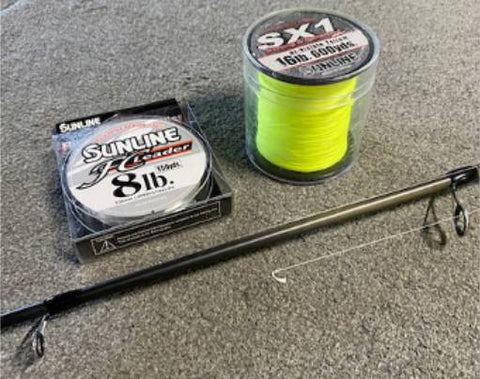Benefits of Using Braid with a Leader with Austin Felix


Braided line is becoming increasingly popular on baitcasting and spinning reels. While an angler can tie their lure straight to the braid, using a fluorocarbon or nylon leader is another option.
Sunline offers both FC Leader and Nylon Leader materials that are explicitly designed for this. Another specific leader material called the Tepa Tapered FC Leader is a new one for 2023/2024. This line allows for an angler to do one of two things:
- Tie the stronger end of the leader to the braid to increase knot strength while keeping a thinner diameter by the lure.
- Tie the thinner diameter of the leader to a small matching diameter braid while having more strength at the lure if fishing around structure.
Bassmaster Elite Series pro angler Austin Felix has a lot of knowledge about using braid with a leader, as he uses it with several different techniques that most anglers don’t. Straight braid is a necessity for techniques such as throwing a frog or flipping a punch rig in grass mats, but there are many other techniques that tying a fluorocarbon or nylon leader to a braided line would be beneficial. Below are some benefits of doing this.
1. Low Stretch
Braided line has zero to little stretch, which can benefit techniques that require hard hooksets, such as flipping a jig or Texas rig. A fluorocarbon leader tied to braid rather than straight fluorocarbon will maximize hook penetration due to the braid’s low stretch and superior strength.
Felix claims that low stretch can also be beneficial for lures such as bladed jigs, lipless crankbaits, and swimming a worm when there is more grass than usual beneath the surface. In this scenario, less stretch allows for the angler to rip the lure out of the grass more effectively to give the lure its maximum performance.
2. More Sensitivity
It can often be challenging to detect a bite when using fluorocarbon or nylon, especially when the fish are sluggish. Because braid has more sensitivity than fluorocarbon or nylon, using braid with a leader can be beneficial. Just as low stretch can help rip lures out of heavy submerged grass, Felix claims that having more sensitivity can also benefit this technique so that an angler can tell the difference between what a bite feels like versus being hung in the grass.For this technique, Felix prefers 30-pound green Siglon PEx8 paired with 16-20-pound Sniper fluorocarbon, depending on how thick the grass is. He also claims that the PEx8 is smoother when it runs through the guides, and it helps with feeling vibration.
3. Less Visibility
Braided line isn’t clear like fluorocarbon or nylon, so the fish are likelier to see it. Using a leader will help with this while still providing the low stretch, high sensitivity, and increase of casting distance, which are crucial in certain situations. Spinning rods with light lines are common on the Bassmaster Elite Series, especially when lakes are dominated by smallmouth or spotted bass.
Felix has had great success using spinning setups. Seven of his nine Elite Series top 10s (including his win at Lake Oahe in 2022) came from utilizing finesse techniques on spinning rods with light lines. Felix prefers a Sunline Sniper fluorocarbon leader tied to a high-visibility pink sinking braid called Sunline Almight. He always uses braid-to-leader on his spinning combos by matching the diameters together to prevent issues with casting or breakage.
For instance, if he uses a 7-pound braid, he will use a 5-7-pound leader, a 13-pound braid tied to an 8-10-pound leader, and a 16-18-pound braid tied to a 15-pound leader when skipping docks or something that requires a short, accurate cast. Regarding the length of his leader, he always uses one long enough for his FG knot to still be in his reel before making a cast, usually 15 to 20 feet long.
4. Less Respooling
When flipping heavy cover, fluorocarbon can wear out quickly. Because of this, an angler might often strip all the line off a baitcasting reel, which can get expensive after a few fishing trips. One of the biggest benefits of braided line is that it lasts much longer than fluorocarbon or nylon which means it can be used longer without respooling. Using a leader connected to braid is much cheaper than using straight fluorocarbon or nylon.
When flipping, Felix always sets his drag loose enough for the line to give a few inches when he sets the hook so that it doesn’t put too much stress on the FG knot. He uses an orange 40-pound Siglon PEx8 braid tied to a 15-to-20-foot fluorocarbon leader, and the type of fluorocarbon depends on what type of cover he is fishing.
Felix uses 15-pound Sniper tied to his braid when flipping a lighter jig, 20-pound Sniper tied to his braid when flipping submerged milfoil, and 22-25-pound Shooter tied to his braid when flipping docks because of its superior abrasion resistance. When his leader gets old, he saves money by replacing it rather than replacing all the line on the spool. To read about other ways to save money on fishing line, check out one of our recent blogs here.
5. Casts Further
Braided line is slicker and thinner in diameter than fluorocarbon and nylon lines, which means that it goes through the rod guides easier resulting in further casting distance. If you want to increase your casting distance, use braid-to-leader rather than straight fluorocarbon or nylon.
Casting a big topwater bait is one technique that requires long casts. For this technique, Felix prefers green 30-pound Siglon PEx4 braid tied to a 20-pound Super Natural Nylon Monofilament 3-foot leader to keep the braid from getting tangled up in the hooks.

